10 Blue Flowering Trees + Growing Guide

This post follows our research editorial guidelines.

Towering into the heavens above, a blue flowering tree is a rare and special treat. It’s like they reach up and steal a bit of the sky and bring it down for us to enjoy.
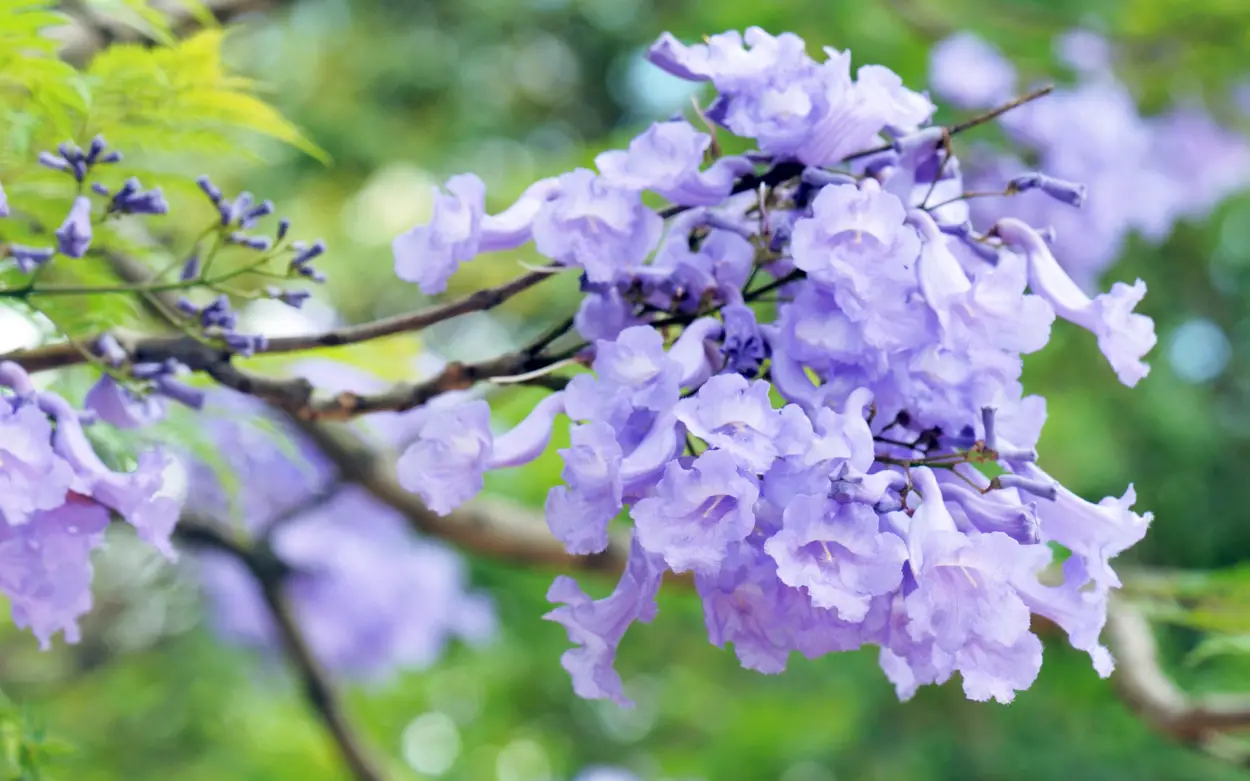
You can discover a bit of that wonder too, no matter whether you’re after a sprawling shade tree like the green ebony tree, a rare beauty like ironwood, or a versatile choice like a quaresmeira.
Let’s take a look as some of my favorites.
Table of Contents
1. ‘Victoria’ California Lilac (Ceanothus thyrsiflorus )
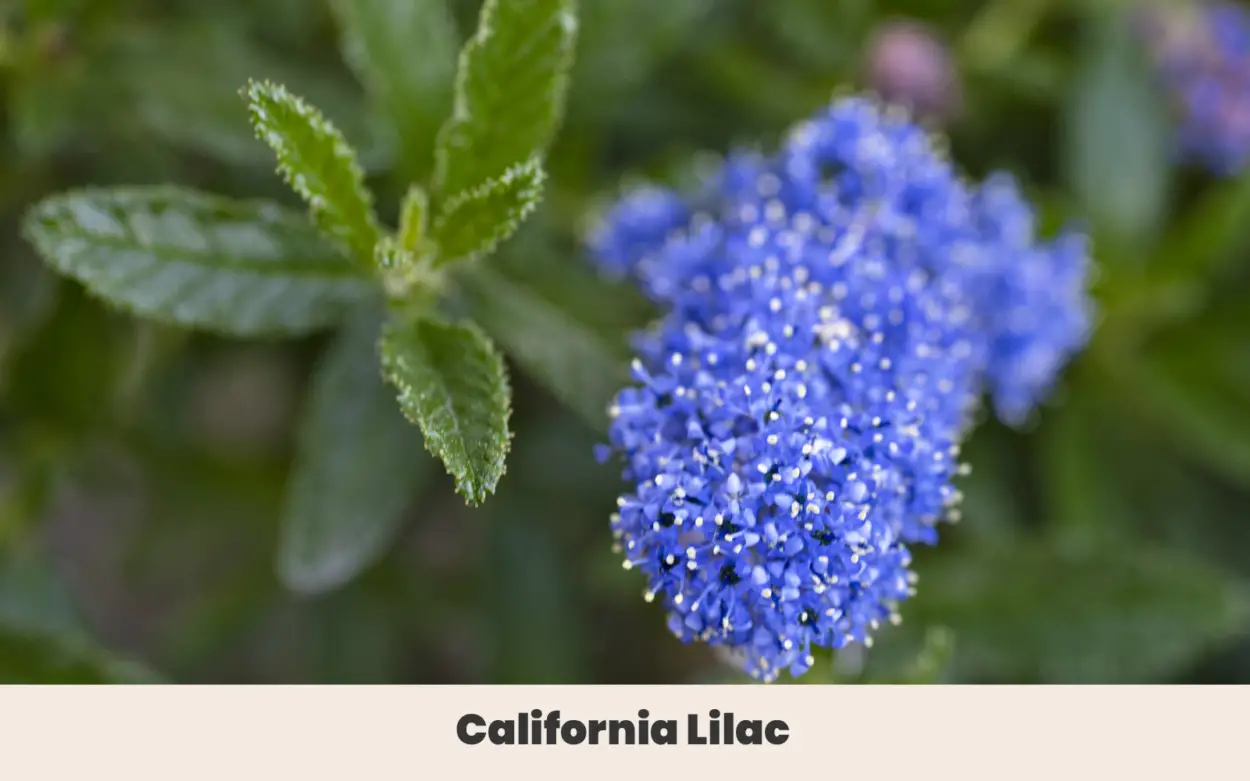
Also known as blue blossom or blue mountain lilac, this stunning evergreen shrub is native to California and Oregon. While it typically grows in a tightly leafed low growing shrub, spoil it and you’ll be rewarded with a massive 6 meter high tree covered in tight clusters of blue blooms known as a thyrse.
They are a great choice for folks keen on supporting migrating hummingbirds, butterflies and friendly garden insects.
| Botanical Name: | Ceanothus thyrsiflorus ‘Victoria’ |
| Growth Rate: | Fast |
| Approximate Mature Size: | 6m (20’) high and wide |
| Native Range: | California and Oregon |
| Hardiness Zones: | 5a to 9b |
| Soil Needs: | Loamy and sandy soils |
| Exposure: | Full sun to partial shade |
| Blooming Period: | Spring |
| Water needs: | Low to moderate; drought tolerant |
2. Blue Rose of Sharon (Hibiscus syriacus)
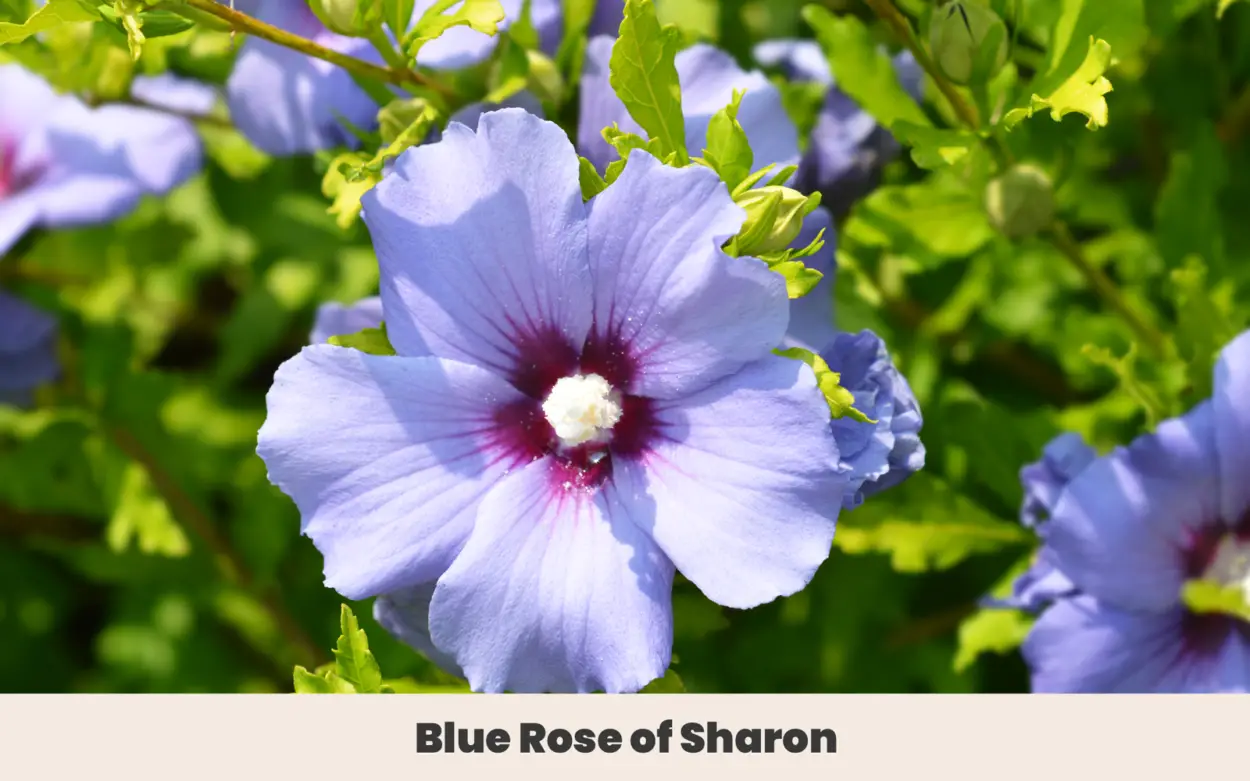
The Rose of Sharon is one of those striking flowers that always screams ‘summer’ to me. This easy-going bloom is also an easy grower and presents few problems to even the beginner gardener.
It’s been cultivated in a fantastic array of colors, including a gorgeous spread of blues and lilacs that earned its place on this list. It can be pruned into a hedge or shrub, but left to its own devices it’ll become a lean, tall tree of around twelve feet tall.
| Botanical Name: | Hibiscus syriacus |
| Growth Rate: | Slow to moderate |
| Approximate Mature Size: | Up to 4m (12’) tall and up to 3m (9’) across |
| Native Range: | China and India |
| Hardiness Zones: | 5b to 9a |
| Soil Needs: | Tolerates most soils |
| Exposure: | Full sun to partial shade |
| Blooming Period: | Summer |
| Water needs: | Moderate to high |
3. Blue Butterfly Bush (Buddleja davidii)
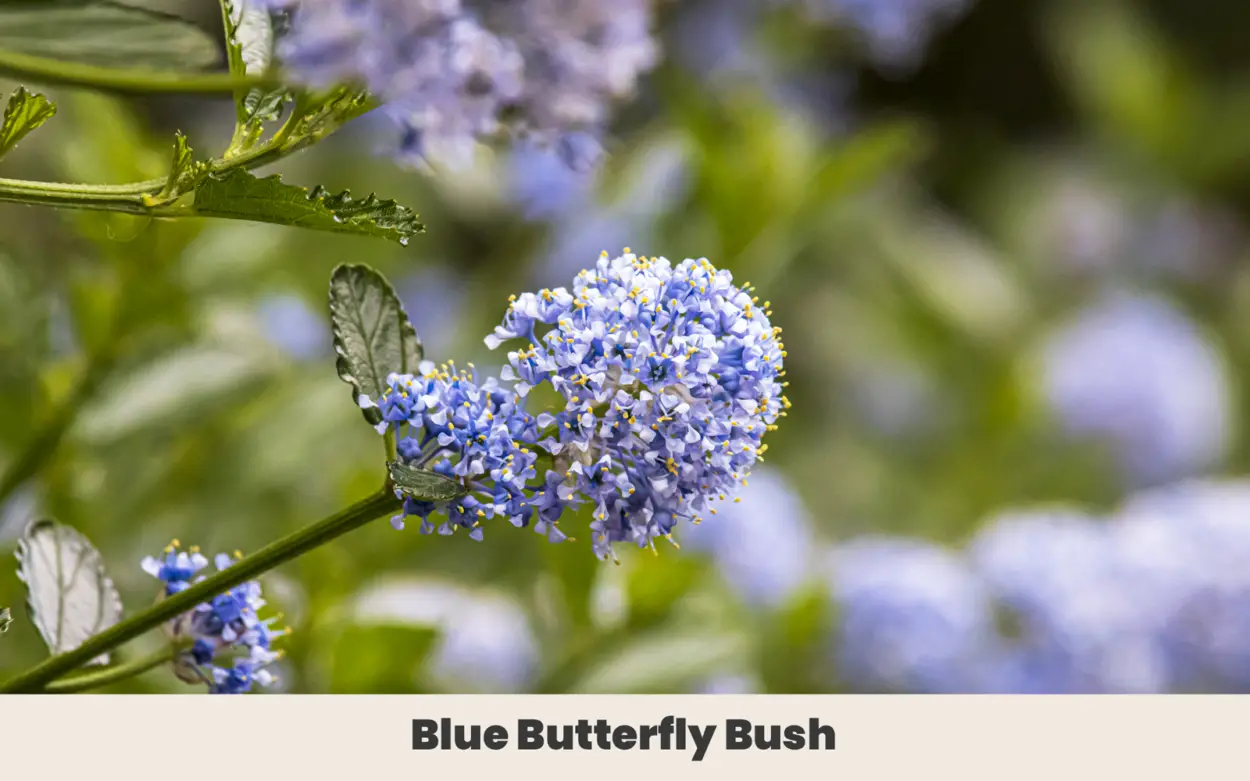
Also known as summer lilac, this charming plant makes a big statement with elegant cane-like trunks, silvery foliage and dramatic dusters of lavender and lilac blue blooms. It’s tough as nails and grows at a rate of knots, so be careful where you plant.
It’s been known to break out of gardens, so be sure to select one of the many non-invasive cultivars like Blue Chip or Blue Heaven. Pruning heavily each winter will help restrict spread, and prompts bigger displays the following summer. Deadheading will also keep it pretty and pristine while preventing the spread of seeds.
| Botanical Name: | Buddleja davidii |
| Growth Rate: | Fast |
| Approximate Mature Size: | Up to 4m (12’) high and 3m (9’) wide |
| Native Range: | Tibet to central China |
| Hardiness Zones: | 5a to 9b |
| Soil Needs: | Tolerates most soil types |
| Exposure: | Full sun |
| Pests: | Prone to spider mites in dry weather |
| Blooming Period: | Spring to summer |
| Water needs: | Low to moderate |
4. Blue Chinese Wisteria Tree (Wisteria sinensis)
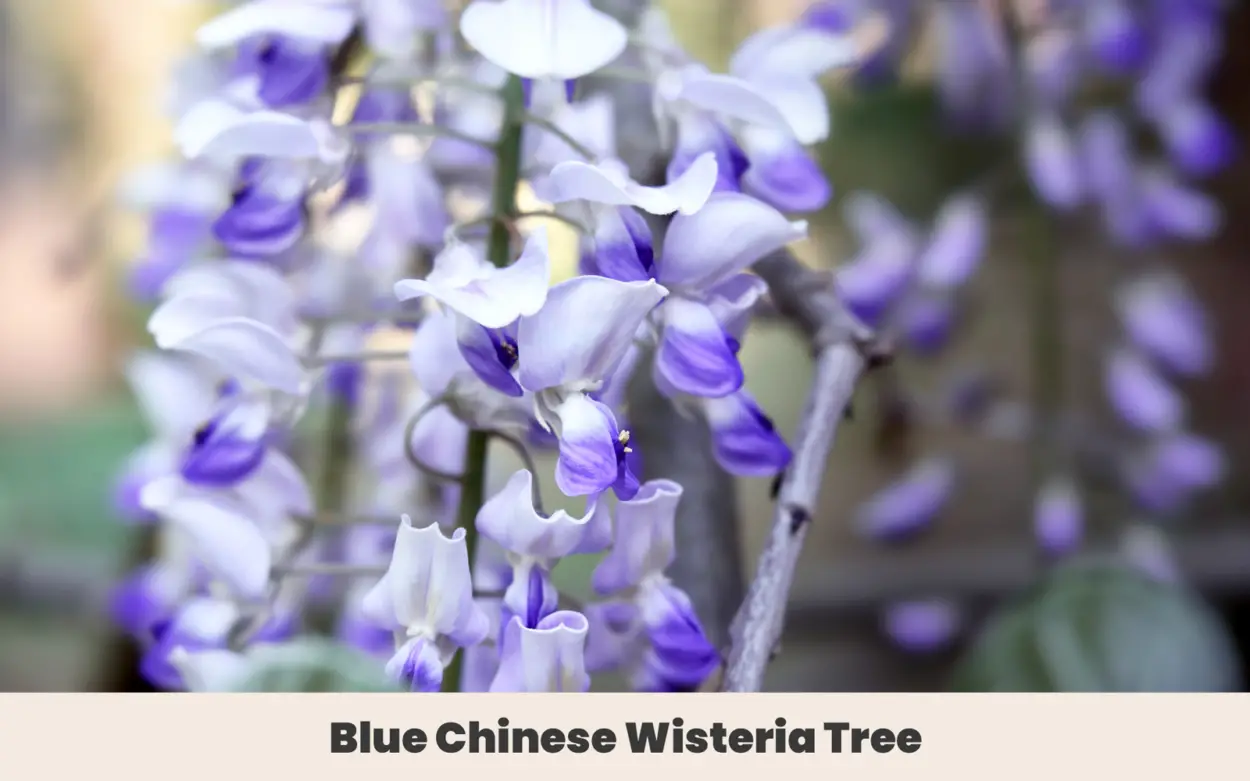
The drooping, swaying flower clusters of the blue Chinese wisteria seem to drip imperial serenity, but this plant is as hardy as a village mule and just as hard to kill. It’s listed in many parts of the world as an invasive species, prone to making a break for it and crowding out native plants.
If you’re lucky enough to live somewhere it’s sensible to grow wisteria, it’s worth the effort. It grows easily as a tree or shrub and blooms dramatically with clockwork precision.
| Botanical Name: | Wisteria sinensis |
| Growth Rate: | Fast |
| Approximate Mature Size: | Up to 8m (25’) tall and 2.5m (8’) across |
| Native Range: | China |
| Hardiness Zones: | 5 to 8 |
| Soil Needs: | Mildly acidic soils of most types |
| Exposure: | Full sun |
| Diseases: | Disease resistant |
| Blooming Period: | Late spring to summer |
| Water needs: | Moderate |
5. Green Ebony Tree (Jacaranda mimosifolia)
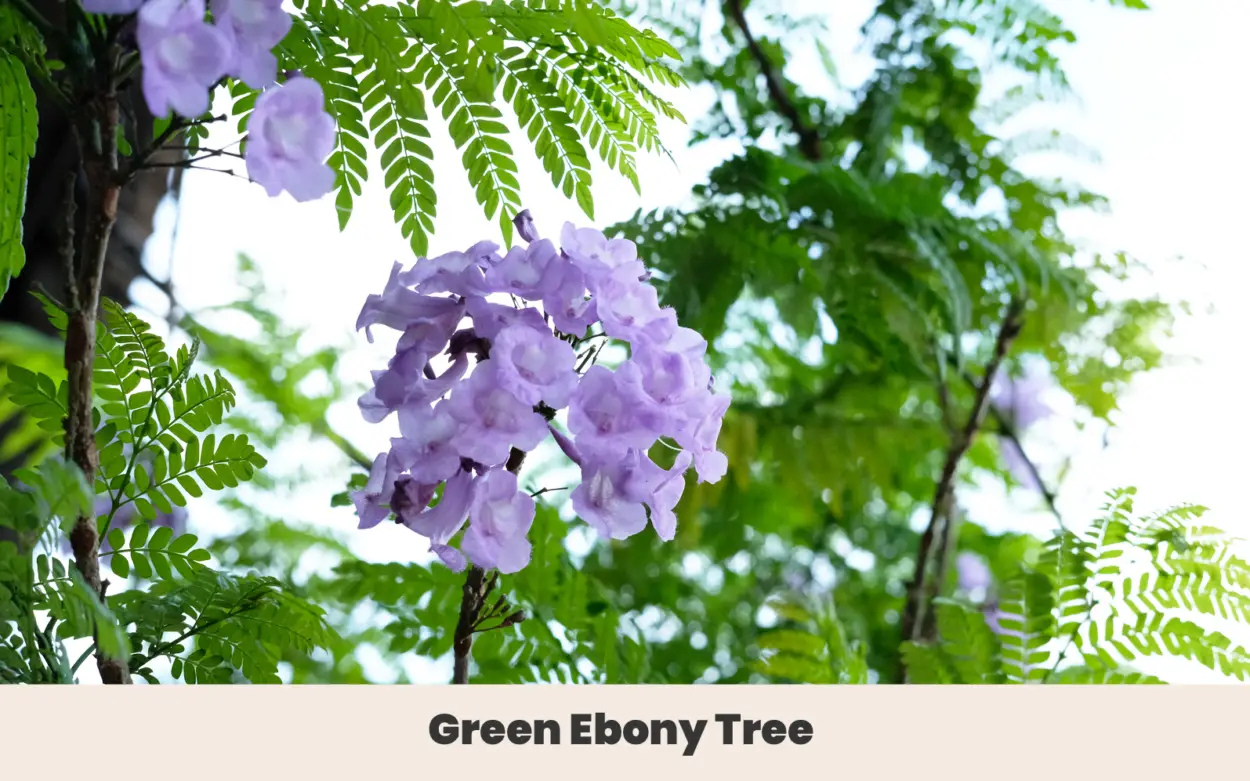
Also known as jacarandas, the green ebony tree is a dramatic bloomer all through the early spring and summer. It flowers so heavily that the entire tree becomes a single mass of lilac-blue, radiant and thrumming with the work of honeybees and other insects.
Out of their flowering period, they are exquisite shade trees with a broad spread of invitingly easy-to-climb branches. While I personally love them, gardeners in the tropics ought to plant with care – they produce clam-shaped seed pods bursting with light, free-traveling seeds that spread rapidly out of the garden.
| Botanical Name: | Jacaranda mimosifolia |
| Growth Rate: | Fast |
| Approximate Mature Size: | 12m (40’) across and wide |
| Native Range: | South-central South America |
| Hardiness Zones: | 9b to 11 |
| Soil Needs: | Tolerates most soils |
| Exposure: | Full sun |
| Blooming Period: | Late spring to early summer |
| Water needs: | Low, drought tolerant |
6. Ironwood (Memecylon umbellatum)
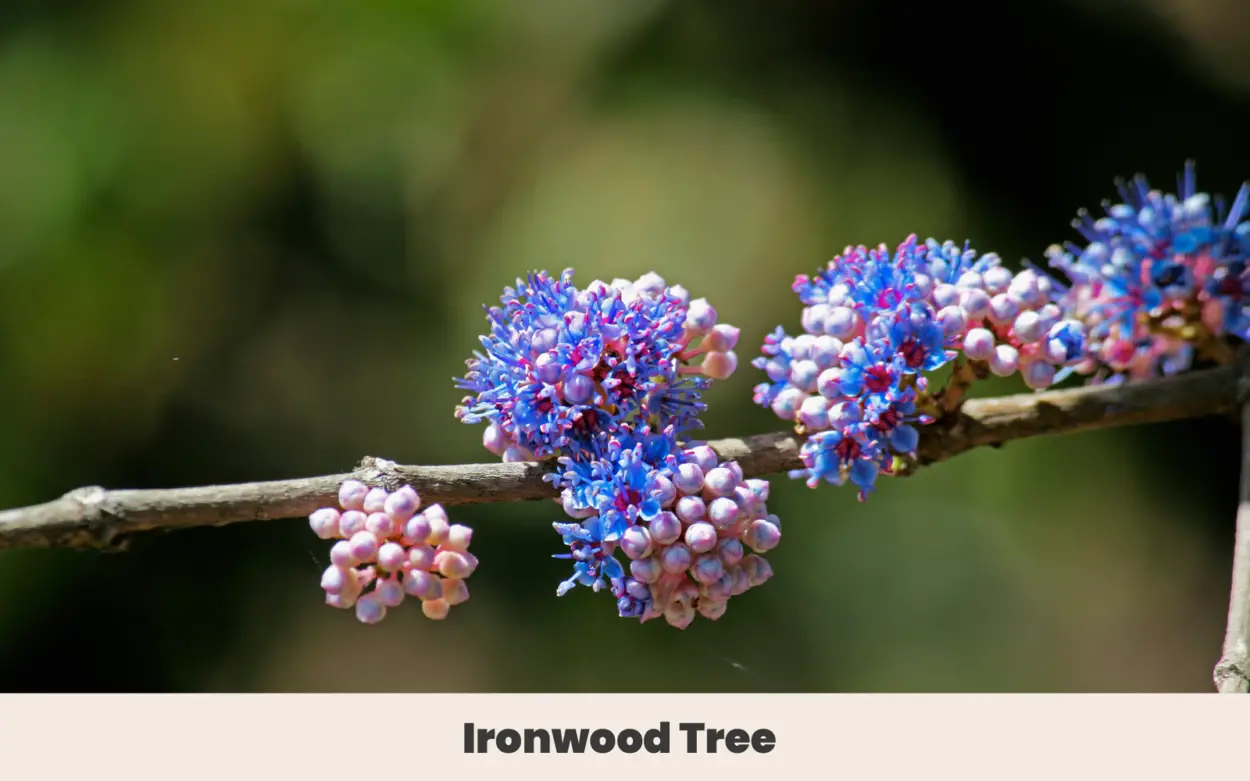
Plump pom-pom clusters of blossoms in bright, true shades of blue put the ironwood in a class all its own. Unlike many plants, the blooms sprout directly from the branches and can cover them entirely, leaving the foliage obscured. Ironwood trees grow to a whopping 8 meters tall (24 feet) and are found in the under-story of tropical forests.
The flowers give way to a bright red berry that’s a traditional spice in its native range, and is used as a medicine in Ayurvedic practice
| Botanical Name: | Memecylon umbellatum |
| Growth Rate: | Slow |
| Approximate Mature Size: | 8m (24’) tall and wide |
| Native Range: | India and South Asia |
| Hardiness Zones: | 11-12 |
| Soil Needs: | Tolerates most soil types |
| Exposure: | Full sun to partial shade |
| Blooming Period: | Year round |
| Water needs: | Moderate |
7. Blue Diamond (Rhododendrons)
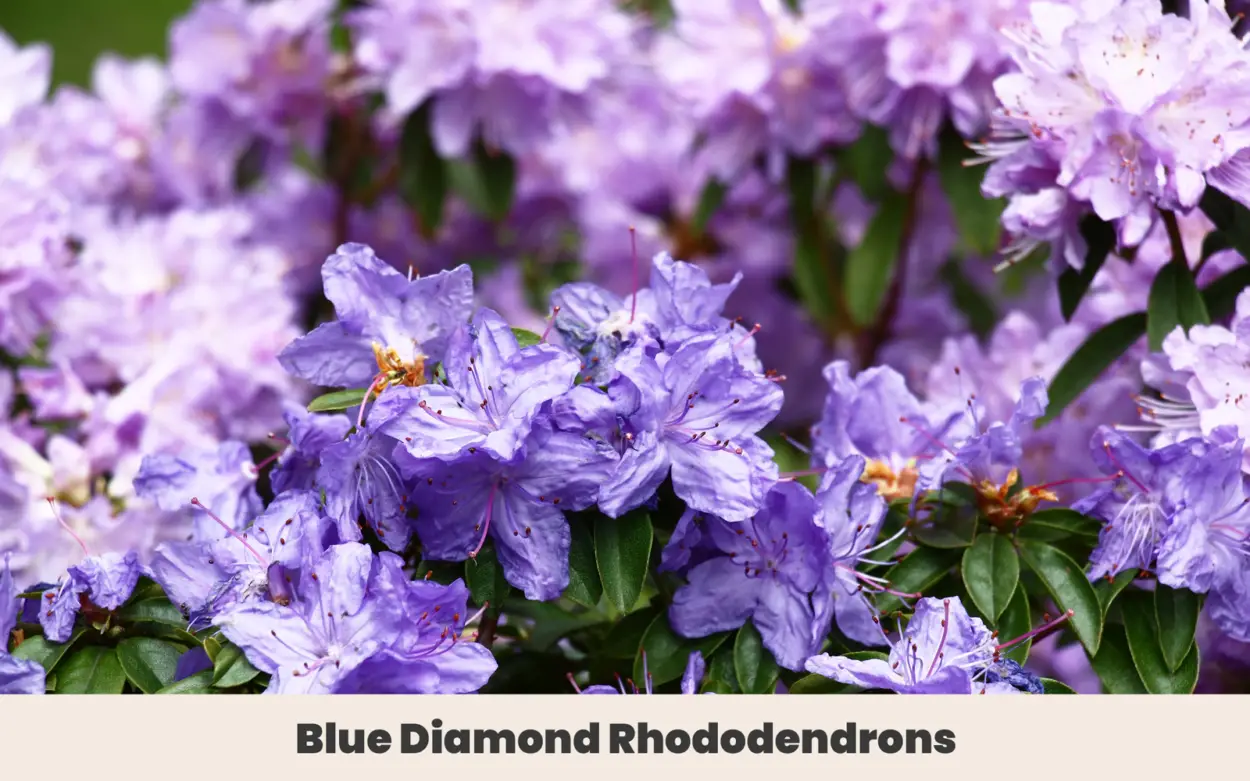
Blue Diamonds is a compact, evergreen shrub just as precious as the name would suggest. It produces clusters of open, blowsy flowers. Given the right conditions, the whole plant may well become so deeply covered in blooms that it’s possible to lose sight of the foliage.
Rhododendrons as a whole are very poisonous, so avoid growing them away from the curious nibbling of children or pets.
| Botanical Name: | Rhododendron ‘Blue Diamond’ |
| Growth Rate: | Slow |
| Approximate Mature Size: | 1m (3’) tall and wide |
| Native Range: | Man-made cultivar, parent plant is native to China |
| Hardiness Zones: | 4a to 8b |
| Soil Needs: | Most well draining, acidic soils that are not too clay heavy. |
| Exposure: | Partial shade to deep shade |
| Diseases: | Canker, crown rot, root rot, leaf spot, rusts and mildews. |
| Blooming Period: | Spring |
| Pruning: | Prune to maintain shape |
| Water needs: | Moderate |
8. Chaste Tree (Vitex agnus-castus)
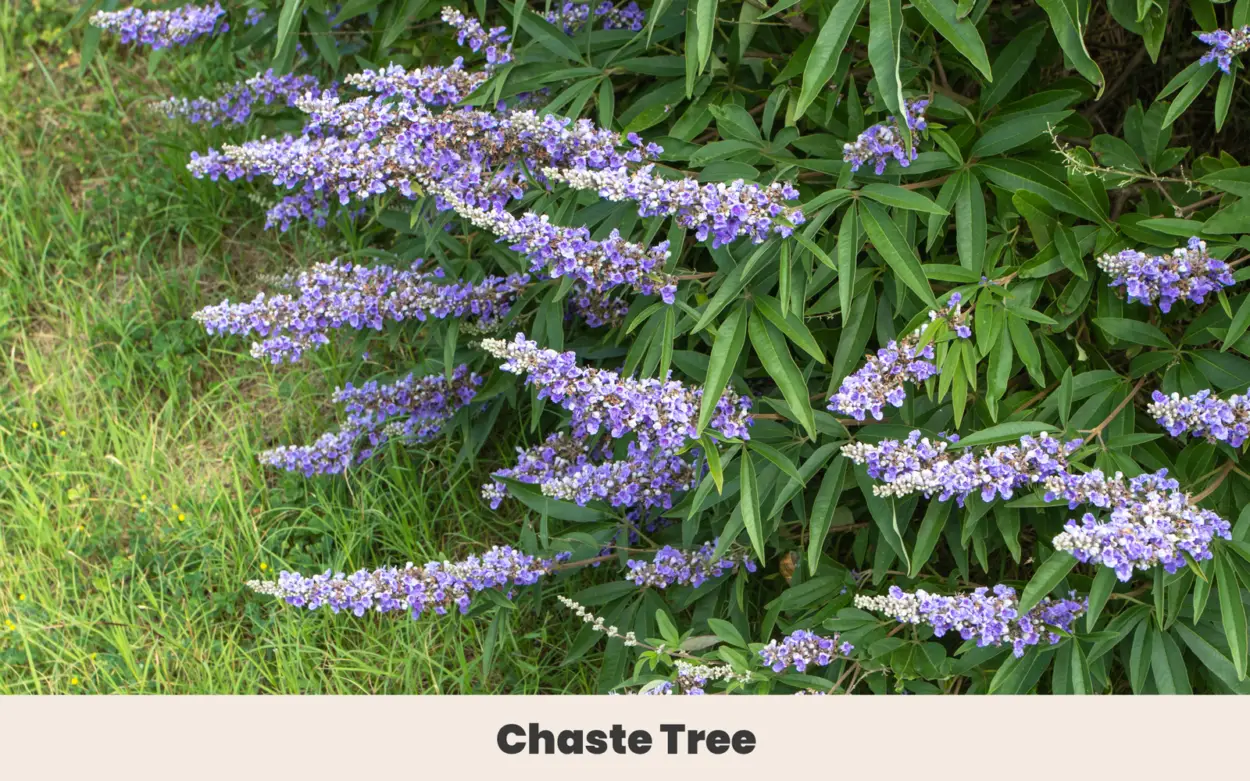
While these days folks use a little blue pill to encourage intimate activity, in other times these little blue flowers were sought out to control it. Regardless of whether you need a brake or accelerator in the bedroom, in the garden, chaste trees are available in a variety of cultivars to suit most needs.
The largest forming sprawling open groves of trees as tall as 6 or 7 meters and just as wide while the smaller ones will fit neatly into containers for a more portable option.
| Botanical Name: | Vitex agnus-castus |
| Growth Rate: | Fast |
| Approximate Mature Size: | 6.5m (20’) tall and wide |
| Native Range: | Mediterranean to Pakistan |
| Hardiness Zones: | 7a to 8b |
| Soil Needs: | Well draining loamy, sandy and clay soils |
| Exposure: | Full sun |
| Blooming Period: | Spring to summer |
| Water needs: | Moderate, drought resistant once established |
9. Holy Wood Tree (Lignum vitae)
Much prized for the heavy hardwood it produces, the holy wood tree is increasingly popular as a slow-growing reliable shade tree in tropical gardens. It flowers year round, and forms wide canopies dappled with clusters of mauve blue blossoms.
Over time they fade to a delicate silvery blue and offer consistent beauty all year round. They often produce tiny golden berries at the same time as their flowers for a truly spectacular display.
| Botanical Name: | Lignum vitae |
| Growth Rate: | Extremely slow |
| Approximate Mature Size: | 10m (30’) tall and 4m (12’) across |
| Native Range: | Florida, Central America and the Caribbean |
| Hardiness Zones: | 10B to 11 |
| Soil Needs: | Well draining sandy, clay or loamy soils |
| Exposure: | Full sun to partial shade |
| Blooming Period: | Year round |
| Water needs: | Low to moderate; drought resistant |
10. Quaresmeira (Tibouchina granulosa)
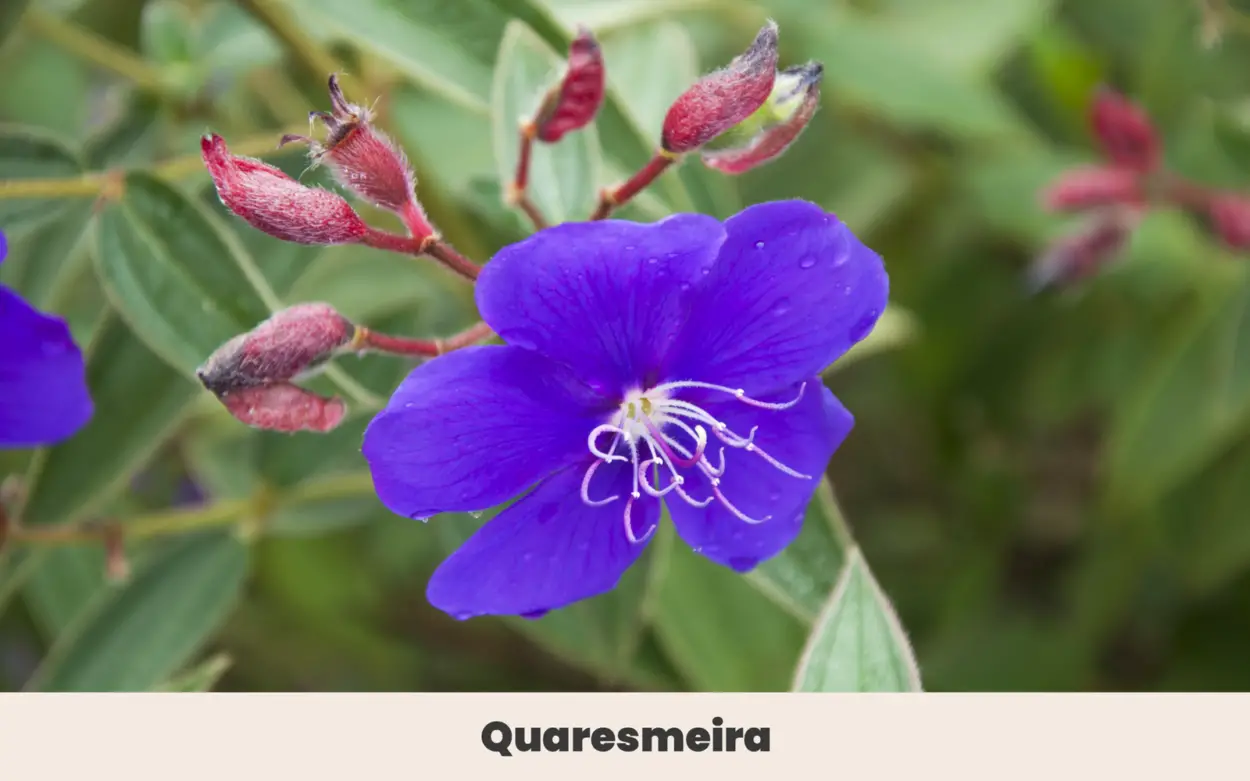
This striking specimen is also known as the purple glory tree, and for good reason. While typically cultivated as a shrub, with a bit of work they can be turned into dramatic twenty foot tall trees covered in velvety green leaves and towering flowers so richly dark they almost seem royal blue. Quaresmeira bloom year round in the right conditions, though the flowers are most bountiful through spring.
| Botanical Name: | Tibouchina granulosa |
| Growth Rate: | Fast |
| Approximate Mature Size: | 6.5m (20’) tall and round |
| Native Range: | Brazil |
| Hardiness Zones: | 10B to 11 |
| Soil Needs: | Well-draining acidic sandy, loamy or clay soils. |
| Exposure: | Full sun |
| Ease of Care: | Moderate |
| Blooming Period: | Year round |
| Water needs: | Moderate |
Final thoughts
There’s nothing quite like a blue flowering tree in full bloom. I love watching bees and butterflies flit from blossom to blossom, their bright blue a calming contrast to radiant foliage and the colorful wings of the visitors. Growing trees takes patience, but the rewards are outstanding.
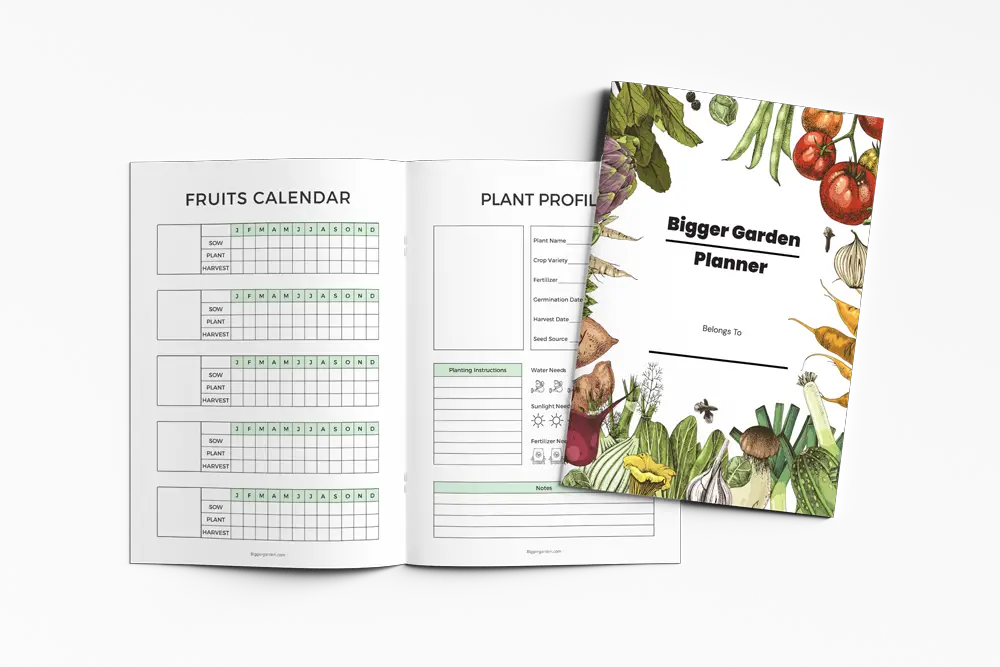
Before you go!
11 Full-Sun Flowering Ground Covers That Will Creep Across Your Garden
12 Pollinator Flowers to Attract Honey Bees to Your Garden
11 Stunning Red Perennial Flowers That Bloom All Summer + Growing Guides
10 Outrageous Orange Perennial Flowers To Grow In Your Garden